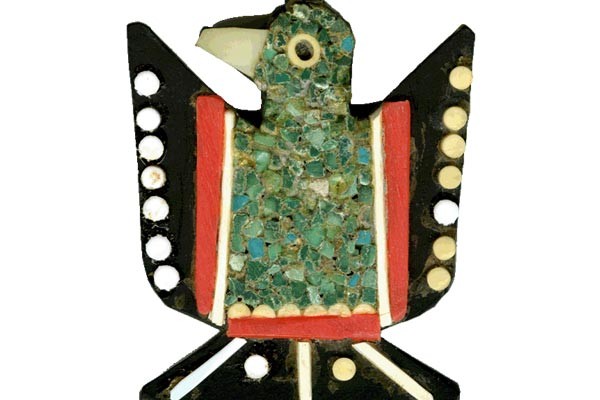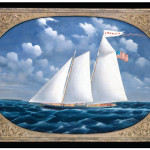 Jewelry may not be what typically comes to mind when you think of “folk art.” But by its very definition, folk art is simply everyday art deeply rooted in culture and traditions. And once you learn the history behind the Santo Domingo Thunderbird design, you’ll understand why it’s considered such an integral part of that tribe’s history. Theirs is a story of perseverance and innovation and it’s one I think (and hope) you’ll find inspirational.
Jewelry may not be what typically comes to mind when you think of “folk art.” But by its very definition, folk art is simply everyday art deeply rooted in culture and traditions. And once you learn the history behind the Santo Domingo Thunderbird design, you’ll understand why it’s considered such an integral part of that tribe’s history. Theirs is a story of perseverance and innovation and it’s one I think (and hope) you’ll find inspirational.
While our museum exhibits traditionally feature New England and Southern paintings and artifacts, this weekend we’re unveiling a beautiful display of Southwestern Indian Art. For the Santo Domingo, jewelry and pottery have always been a large part of their heritage, dating back for centuries. This particular style of Thunderbird necklaces and earrings started to appear around the 1930s just as the effects of the Great Depression were being felt.
During those tough economic times, jewelry making became a means of survival for the tribe. Because the Pueblo was located so close to Santa Fe (a rapidly growing tourist destination), an opportunity presented itself to generate income. Little did they know, the trinkets they sold as souvenirs would one day be considered works of art. It may even more shocking when you hear what they were made of. Look closely. Those pendants and tabs were created using cheap plastic, deer bones—even car battery casings! All of it was material you and I would have likely considered useless garbage both then… and today.
So what’s the significance of the Thunderbird used in almost all of the Santo Domingo jewelry from this period? I asked Jan Gilliam, manager of exhibit planning for our museums. According to tribal tradition, birds were the only life form allowed to be represented in their pottery and jewelry. “While there are a variety of bird forms, the majority represent the Thunderbird. It’s not certain where the initial design came from but Thunderbirds are found on early petroglyphs in this area,” she told me.
By the early 20th century, the Thunderbird had become a popular motif used in advertising to entice travelers with the “Southwest experience.” When the economy started to rebound 20 to 40 years later, the Santo Domingo jewelers returned to making more traditional styles and using traditional materials. Now, more than 50 years later, these earlier “trinkets” are considered valuable pieces of art that reflect a significant period in history for this culture.
I was lucky enough to get a behind-the-scenes look at quite a bit of the jewelry that will be showcased in Thunderbirds: Jewelry of the Santo Domingo Pueblo ahead of the exhibit opening this Saturday. I was honestly blown away by the simplicity of the beauty discovered in each one-of-a-kind piece. I encourage you to visit and see it for yourself.
The exhibit is a self-guided tour with printed panels of information associated with each case. It will remain open through September of 2016.
Admission to the Art Museums is included with your Colonial Williamsburg ticket but you can also buy a separate single-day ticket just for the museums!




[…] art, and other treasures. There is an abundance of displays to see, including the brand new Thunderbirds: Jewelry of the Santo Domingo Pueblo. A rainy day is the perfect time to spend appreciating and exploring these outstanding museums. You […]